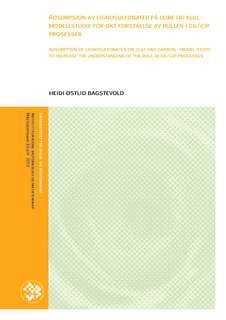| dc.description.abstract | Lignosulfonater, sulfonert lignin, produseres som et biprodukt gjennom sulfittprosessen i produksjonen av cellulose eller ved å sulfonere Kraft lignin. Produktet har gode egenskaper som dispergeringsmiddel og bindemiddel, og det benyttes i en rekke applikasjoner. Oppgaven baserer seg på lignosulfonat som kan benyttes i gruvedrift. I utvinningen av gull benyttes CIL og CIP prosesser, prosesser der gull løses ut med cyanid og deretter skilles ut ved adsorpsjon til aktivt kull. Lignosulfonat brukes i prosessene til å dispergere gullholdig malm, slik at tørrstoffinnholdet økes uten at viskositeten økes. Malmen består hovedsaklig av leire, og det er leirepartiklene som dispergeres av lignosulfonat. Det er usikkert om lignosulfonat påvirker adsorpsjonen av utløst gull til det aktive kullet. Oppgaven undersøker derfor adsorpsjon av lignosulfonat til kull og leire. Ulike lignosulfonater ble analysert. Forskjellige konsentrasjoner av lignosulfonat ble tilsatt kull og leire. Adsorbert mengde lignosulfonat ble funnet ved hjelp av UV absorpsjon. Langmuirs adsorpsjonsisoterm ble benyttet for utregninger av likevektskonstanter og spesifikk overflate for kull og leire. Spesifikk overflate ble også regnet ut ved hjelp av måling av partikkelstørrelse av kull og leire. Adsorpsjonen av lignosulfonat ble sammenliknet for kull og leire basert på mengde substrat og normalisert overflate. Ved sammenlikning av adsorbert mengde lignosulfonat per gram substrat adsorberte det mest lignosulfonat til kull. Likevektskonstantene viste at lignosulfonat har større affinitet for adsorpsjon til leire enn til kull. Dette ble også bekreftet ved å se på den adsorberte mengden lignosulfonat per normalisert overflate, der adsorpsjon av lignosulfonat til leire var størst. I utvinningen av gull er det mye større mengder malm enn kull, og derfor vil lignosulfonat adsorbere til leirpartiklene, og vil derfor sannsynligvis ikke påvirke adsorpsjonen av det utløste gullet til det aktive kullet. Lignosulfonates, sulfonated lignins, is produced as a co-product from the sulfite process in the production of cellulose, or by sulfonation of Kraft lignins. The products have excellent properties as
dispersants and binders, and are used in a variety of applications. This thesis is based on lignosulfonates used in mining. For the recovery of gold, CIL and CIP processes are used. The gold is leached by cyanide solutions and then separated by adsorbing at active coal. Lignosulfonates can
be used in these processes to disperse the ore. The ore consists mainly of clay, and it’s the clay particles that are dispersed by lignosulfonate. It is uncertain whether lignosulfonate affect the adsorption of gold on the active coal. The thesis examines the adsorption of lignosulfonates on coal
and clay. Different lignosulfonates were analyzed. Different concentrations of lignosulfonate were added to coal and clay. Adsorbed amount of lignosulfonate was found using UV absorption. The
Langmuir adsorption isotherm was used for calculations of equilibrium constants and specific surface area of coal and clay. Specific surface was also calculated using particle size measurements of coal and clay. The adsorbed amount of lignosulfonate to coal and clay was compared based on
the amount of substrate and normalized surface. For the adsorption of lignosulfonate based on amount substrate, the coal adsorbed most lignosulfonate. The equilibrium constants showed that
lignosulfonate has a greater affinity for adsorption to clay than to coal. This was also confirmed by looking at the amount of adsorbed lignosulfonate for the normalized surface, where adsorption of
lignosulfonate to clay was greatest. In the process of recovering gold, there are much larger quantities of ore than coal. This means that the lignosulfonat will adsorb to the clay rather than the coal. And therefore, the lignosulfonate will probably not affect the adsorption of the gold on the
active coal. | no_NO |
